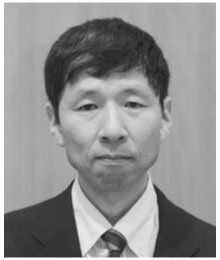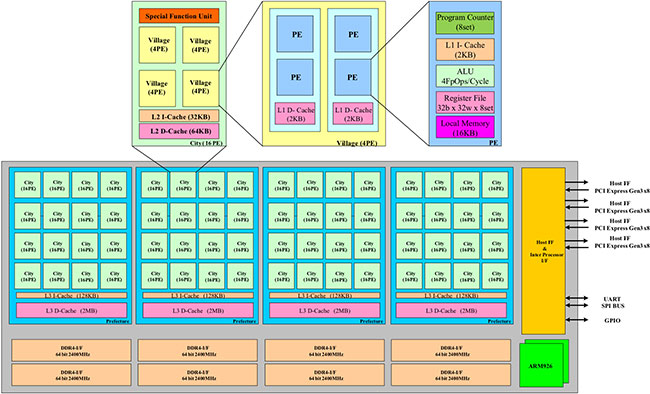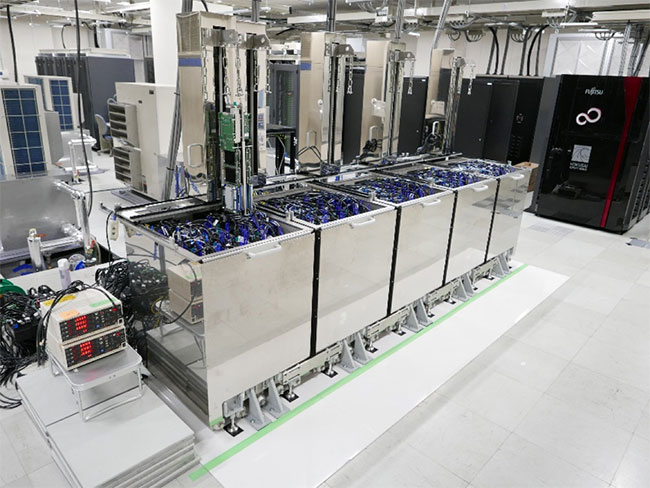Until recently, opportunities to improve supercomputers have been limited by their power consumption and footprints. Against this backdrop, the award recipients carried out research and development across the whole supercomputer system, from processor level through system board level, including the cooling mechanism, and realized a high density and high energy-efficient supercomputer. The supercomputer ZettaScaler series adopts the manycore processor PEZY-SC, which integrates 1,024 cores on a chip (Fig. 1). Each core of PEZY-SC adopts its own instruction set architecture, fine grain multi-threaded processing to realize high efficiency and high integration, enabling simultaneous 2-way superscalar processing at the same time. These cores adopt MIMD (Multiple Instruction-stream Multiple Data-stream) type architecture, meaning that each core can operate independently, which is significantly different from the GPU (Graphic Processing Unit) which has also been utilized in the supercomputer field in recent years. The aim is ease of programming and expansion of application range. Now,, the ZettaScaler-1.0 Suiren developed in 2014 has been certified as ranking second in the November supercomputer energy efficiency Green 500 as a system adopting 32 nodes, 256 PEZY-SC processors. Here, as a cooling technology, we have developed a liquid immersion cooling system that immerses the whole computer directly, in the short time of less than half a year. The whole system is directly immersed in a highly insulating fluorocarbon refrigerant, heat is removed by heat conduction, and the refrigerant is forcibly circulated via a heat exchanger to realize cooling. This not only improves cooling efficiency but also realizes stable operation of the entire system and reduction of current leakage from the semiconductors, giving realistic ease of maintenance, even compared with air cooling.
In ZettaScaler-1.0, due to restrictions on development time, we built a system by remodeling an existing commercial rack mount server for liquid immersion. However, since these were originally based on air cooling, it became impossible to make full use of the high cooling capability of immersion. Therefore, in 2015, the award recipients developed a server called gBrickh that was optimized for immersion cooling and realized it as ZettaScaler-1.5. Shoubu (Fig. 2), which installed this server in a total of 80 bricks into five immersion tanks, was certified as No. 1 in the Green 500 in the spring of 2015, and held that ranking continuously for the following three consecutive periods. Meanwhile, improvement of actual performance was promoted and, in spring of 2016, a supercomputer for the first time exceeded 1PFLOPS (number of floating point instructions executed per second), earning it the first place for high performance with constant performance We showed that a supercomputer can realize superior power efficiency.
As stated above, we are continuing to improve and develop the system on an ongoing basis despite the limited resources of venture companies, adherence to domestic production, and staying with advanced technology development based on the Japanese semiconductor industry. It can be said that this development has significantly raised expectations in the electronics industry that having it recognized as deserving of a performance award is a major achievement. The award recipientsf group of companies developed this year's processor PEZY-SC2 for the second-generation supercomputer and dedicated DRAM, and it is working to build a new system.
Fig.1 Block diagram of PEZY-SC manycore processor.
Fig.2 ZettaScaler-1.6@Shoubu
References
- Sunao Torii, ExaScaler-1: The Power-Efficient Submersion Many-Core Processor Based Supercomputer, COOL chips | XVIII, 2015.
- Hitoshi Ishikawa, "Introducing and future prospective of the ZettaScaler/PEZY-SC series(in Japanese) ", http://atrg.jp/ja/index.php?ATTA2016, ATTA2016
- "Renewal of semi-conductor architecture and cooling systems toward to the Exa-scale computing (in Japanese)", Nikkei Electronics, July and August issue of 2015







